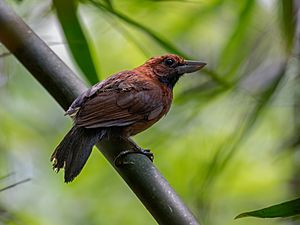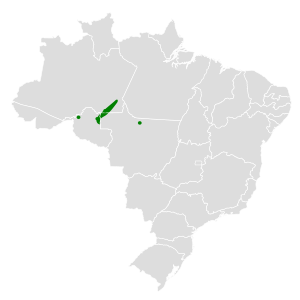Rondônia bushbird facts for kids
Quick facts for kids Rondônia bushbird |
|
|---|---|
 |
|
| Conservation status | |
| Scientific classification | |
| Genus: |
Clytoctantes
|
| Species: |
atrogularis
|
 |
|
The Rondônia bushbird (Clytoctantes atrogularis) is a special type of bird. It belongs to the Thamnophilidae family, which includes many birds found in Central and South America. This bushbird is endemic to Brazil, meaning it lives only there and nowhere else in the world.
Contents
What Does the Rondônia Bushbird Look Like?
The Rondônia bushbird has some interesting features. Male bushbirds are mostly blackish in color. Female bushbirds, on the other hand, are mainly a reddish-brown color, which is called rufous.
One of the most unique things about this bird is its beak. It has a short, strong bill that looks a bit unusual. The lower part of its beak curves upwards, while the top part stays straight. This special beak helps it find food.
Where Does the Rondônia Bushbird Live?
The Rondônia bushbird lives in the dense, wet lowland forests of Brazil. These forests are warm and humid, with lots of trees and plants. It prefers the thicker parts of these tropical forests, making it quite hard to spot.
Because it lives in such dense areas, not much is known about its daily life or habits. It's a bit of a mystery bird! Scientists are still learning about how it lives and what it does.
Why Is This Bird Special?
The Rondônia bushbird was first discovered in 1986. For a while, scientists were worried about it. The place where it was first found had its forest cleared away. Many people feared the bird might have disappeared forever.
However, in 2004, the bird was found again in another part of Brazil! This was great news. Since then, it has been seen in other areas too, including parts of Amazonas, Rondônia, and Mato Grosso states.
These new sightings showed that the bird was more widespread than people first thought. Because of this, its conservation status was changed in 2008. It used to be listed as "Critically Endangered," meaning it was at a very high risk of disappearing. Now, it is listed as "Vulnerable," which means it still needs protection, but it's not in as much immediate danger as before.
Scientists continue to study and protect the Rondônia bushbird and its forest home. Learning more about this unique bird helps us understand how to keep it safe for the future.
See also



